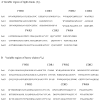Human Monoclonal Fab Antibodies Against West Nile Virus and its Neutralizing Activity Analyzed in Vitro and in Vivo
- PMID: 20505850
- PMCID: PMC2875541
- DOI: 10.4172/jaa.1000005
Human Monoclonal Fab Antibodies Against West Nile Virus and its Neutralizing Activity Analyzed in Vitro and in Vivo
Abstract
The disease progression with West Nile virus (WNV) infection in humans leads to meningitis or encephalitis and may cause death, particularly among elderly and immunocompromised individuals. Passive immunity using immunoglobulins has shown efficacy in treating some patients with WNV infection, which makes the development of human anti-WNV antibodies significant. The goal of this study was to construct a Fab-specific phage display library against WNV, and to identify and select clones with neutralizing activities. Total RNA was extracted from peripheral blood lymphocytes (PBLs) of two immunized individuals, and RT-PCR was used to amplify the Fab fragments containing the heavy (V(H)) and light (V(L)) chains. The amplified genes were sequentially cloned into the recombinant antibody expression vector pComb3-H, and the Fab-specific phage display library was packaged with helper phage VCS-M13. Five rounds of panning were carried out with WNV E protein domain III, and then binding antibodies were selected by ELISA. Antigen binding specificity, complementarity determining region (CDR) sequence of V(H) and V(L), and neutralizing activity against WNV were analyzed in vitro and in vivo. Eight Fab monoclonal antibodies recognized E protein domain III from a library of 7×10(7) clones/ml. Of the eight, one (Fab 1), exhibited significant neutralizing activity, and completely blocked 100 pfu WNV infection in Vero cells at a concentration 160 μg/ml. In contrast, Fab 13 and Fab 25, showed weaker neutralizing activities, and modestly blocked 100 pfu WNV infections at concentrations of 320 μg/ml and 160 μg/ml, respectively. However, animal studies showed that Fab 1 failed to protect mice from death at the concentration of 160μg/ml indicating that the neutralizing potential of an antibody in vivo is determined by the strength of binding and the abundance of its epitope for the virion.
Conflict of interest statement
Figures




Similar articles
-
[Construction and preliminary panning of Fab phage display antibody library against respiratory syncytial virus].Zhongguo Dang Dai Er Ke Za Zhi. 2008 Dec;10(6):681-5. Zhongguo Dang Dai Er Ke Za Zhi. 2008. PMID: 19102829 Chinese.
-
[Construction and identification of a sizeable naive human Fab phage display antibody library].Zhonghua Liu Xing Bing Xue Za Zhi. 2025 Feb 10;46(2):288-295. doi: 10.3760/cma.j.cn112338-20240801-00468. Zhonghua Liu Xing Bing Xue Za Zhi. 2025. PMID: 39965836 Chinese.
-
Human Fab antibodies derived from phage display library neutralize hepatitis A virus in vitro.Zhonghua Shi Yan He Lin Chuang Bing Du Xue Za Zhi. 2000 Dec;14(4):313-6. Zhonghua Shi Yan He Lin Chuang Bing Du Xue Za Zhi. 2000. PMID: 11471014
-
A protective human monoclonal antibody targeting the West Nile virus E protein preferentially recognizes mature virions.Nat Microbiol. 2019 Jan;4(1):71-77. doi: 10.1038/s41564-018-0283-7. Epub 2018 Nov 19. Nat Microbiol. 2019. PMID: 30455471 Free PMC article.
-
In vitro enhancement of Zika virus infection by preexisting West Nile virus antibodies in human plasma-derived immunoglobulins revealed after P2 binding site-specific enrichment.Microbiol Spectr. 2024 Jun 4;12(6):e0075824. doi: 10.1128/spectrum.00758-24. Epub 2024 Apr 30. Microbiol Spectr. 2024. PMID: 38687079 Free PMC article.
Cited by
-
Phage display-derived human antibodies in clinical development and therapy.MAbs. 2016 Oct;8(7):1177-1194. doi: 10.1080/19420862.2016.1212149. Epub 2016 Jul 14. MAbs. 2016. PMID: 27416017 Free PMC article. Review.
-
Developing Recombinant Antibodies by Phage Display Against Infectious Diseases and Toxins for Diagnostics and Therapy.Front Cell Infect Microbiol. 2021 Jul 7;11:697876. doi: 10.3389/fcimb.2021.697876. eCollection 2021. Front Cell Infect Microbiol. 2021. PMID: 34307196 Free PMC article. Review.
-
Infectious disease antibodies for biomedical applications: A mini review of immune antibody phage library repertoire.Int J Biol Macromol. 2020 Nov 15;163:640-648. doi: 10.1016/j.ijbiomac.2020.06.268. Epub 2020 Jul 8. Int J Biol Macromol. 2020. PMID: 32650013 Free PMC article. Review.
-
Antibody Phage Display Technology for Sensor-Based Virus Detection: Current Status and Future Prospects.Biosensors (Basel). 2023 Jun 9;13(6):640. doi: 10.3390/bios13060640. Biosensors (Basel). 2023. PMID: 37367005 Free PMC article. Review.
-
Recombinant antibodies for diagnostics and therapy against pathogens and toxins generated by phage display.Proteomics Clin Appl. 2016 Oct;10(9-10):922-948. doi: 10.1002/prca.201600002. Epub 2016 Jun 21. Proteomics Clin Appl. 2016. PMID: 27198131 Free PMC article. Review.
References
-
- Agrawal AG, Petersen LR. Human immunoglobulin as a treatment for West Nile virus infection. J Infect Dis. 2003;188:1–4. - PubMed
-
- Barbas CF, III, Burton DR. Monoclonal antibodies from combinatorial libraries. Cold Spring Harbor Laboratory Cousre P; 1994. pp. 31–35.
-
- Barbas CF, III, Lerner RA. Combinatorial immunoglobulin libraries on the surface of phage (phabs): rapid selection of antigen-specific Fabs. Methods. 1991;2:119–124.
-
- Ben-Nathan D, Lustig S, Tam G, Robinzon S, Segal S, et al. Prophylactic and therapeutic efficacy of human intravenous immunoglobulin in treating west nile virus infection in mice. J Infect Dis. 2003;188:5–12. - PubMed
Grants and funding
LinkOut - more resources
Full Text Sources
